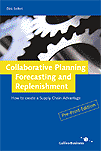

Collaborative Planning Forecasting and Replenishment:
How to create a Supply Chain Advantage
One of the first books to focus on CPFR (too many focus on how enterprises work together and don't give credit where it's due) this is good in most places.
Dirk Siefert who has written long and lasting on ECR makes too many mistakes in following the faulty European line that describes CPFR as nothing other than one aspect of "what ECR is all about anyway". In truth, ECR is the last of a long line of initiatives that have their root in MRP back in the 1970s, though ECR was an excellent "best in class" initiative for its heritage. But, ECR like all previous efforts, are rooted in "the enterprise" whereas CPFR is one a small handful of initiatives rooted in "the 2 in B2B". CPFR and ECR are quite different. The Europeans, who generally did a better job with ECR, did not want an American Revolution to replace their efforts, so they subsumed CPFR and made it one small part of the overall ECR effort. And so Siefert, not versed in the details of CPFR and its real past, follows the party line. Avoid the fluff and head to the papers recommended below.
The highlights of the book for me are Joe Andraski's "next movement in SCM". Joe knows more about CPFR than anyone, and not just about the model but how did the model come about, and what does the model really mean. His paper alone is enough to buy the book. I also have to thank Joe for references n-tier CPFR and the Interoperability issues connected with CPFR. They are two major longer term opportunities for enterprises - period. It was a pleasure for me to work with Joe and many others for the last few years at the Committee.
There are some other notable papers that are to be followed with after reading Andraski, such as Julie Fraser (Industry Directions), Tom Friedman and Greg Belkin (Moonwatch Media), and frankness of Lawrence Fennell (Wal*Mart). Two other notes that I did like were by Ralph Dreyer (one of the old CPFR's), and the Robert Bruce and Ron Ireland (to other old CPFR's). There are several case studies from colleagues of mine - Henkel Spain is a great note. I did not agree fully with Georg Engler (Accenture) issues and conclusions about CPFR scalability, but the note is a good introduction.
The book has some great graphics and tables. But it has its fair share of errors and confusion. One note by Prof. D. Gerhard Arminger, called "Sales and Order Forecasts in CPFR Process for Retail" says, "...a mechanism has to be found that reconciles the sales and order forecasts of the retailer and the manufacturer if they differ." This is a) the whole point of CPFR in the first place (the fact that separately developed plans that are actually looking at the same thing, are always different), and b) the difference between the sales and order forecast is to the uninitiated, DRP. For retailers who know not DRP, they will spend the next 5 years seeking to increase their IQ as they try to catch up with that part of the human race that "learned" this from the Master, Andre Martin, back in the early 1980s. For those that know what DRP is, they will steal an advantage.
Andrew White